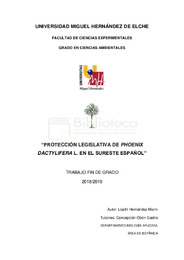Por favor, use este identificador para citar o enlazar este ítem:
https://hdl.handle.net/11000/27117Registro completo de metadatos
| Campo DC | Valor | Lengua/Idioma |
|---|---|---|
| dc.contributor.advisor | Obon, Concepcion | - |
| dc.contributor.author | Hernández Marín, Lizeth | - |
| dc.contributor.other | Departamentos de la UMH::Biología Aplicada | es_ES |
| dc.date.accessioned | 2022-05-16T12:20:55Z | - |
| dc.date.available | 2022-05-16T12:20:55Z | - |
| dc.date.created | 2019-12-11 | - |
| dc.identifier.uri | http://hdl.handle.net/11000/27117 | - |
| dc.description.abstract | La palmera datilera, perteneciente a la familia Arecaceae (Palmae), que se encuentra en mayor o menor medida por el sureste peninsular. Es bien conocido el enorme interés que tiene en nuestra cultura mediterránea, tanto para el medio ambiente, por ser uno de los elementos más importantes en los huertos, como para la economía de algunos sectores populares, teniendo en la actualidad, a parte de un valor ornamental, utilidad en la artesanía. Estas y otras importantes características, como su valor cultural, han sido las razones fundamentales para ser considerada como el símbolo vegetal de nuestra Península. El objetivo de este trabajo es el análisis de forma crítica de las diferentes normativas realizadas en las últimas décadas acerca de la protección legal y el fomento de la palmera datilera (Phoenix dactylifera L.), con el fin de garantizar su continuidad histórica. En este estudio se ha pretendido determinar los distintos niveles de legislación, desde los marcos legislativos europeos hasta los marcos legislativos locales. Se tomó como base para el estudio los artículos publicados en el B.O.E, así como diversas publicaciones internacionales y europeas realizadas por diferentes ramas científicas, cuya finalidad es el amparo legal de P dactylifera. La palmera datilera está excluida de la legislación estatal española, quedando descartada de la Ley 42/2007, de 13 de diciembre, del Patrimonio Natural y de la Biodiversidad. Por tanto, no está protegida por la Unión Europea. | es_ES |
| dc.description.abstract | The date palm, belonging to the family Arecaceae (Palmae), is found to a greater or lesser extent in the southeasternt peninsular. It is well known the enormous interest that has in our Mediterranean culture, both for the environment, being one of the most important elements in the orchards, and for the economy of some popular sectors, taking today, aside from an ornamental value, usefulness in crafts. These and other important characteristics, such as its cultural value, have been the fundamental reasons to be considered as the plant symbol of our Peninsula. The objective of this work is the critical analysis of the different regulations made in recent decades about legal protection and the promotion of the date palm (Phoenix dactylifera L.), in order to ensure its historical continuity. This study sought to identify the different levels of legislation, from European legislative frameworks to local legislative fremeworks. The study was based on articles published in the BOE, as well as various international and European publications produced by different scientific branches, whose purpose is the legal protection of Phoenix dactylifera L. The date palm is excluded from Spanish state legislation, and is excluded from Law 42/2007, os December 13, on Natural Heritage and Biodiversity. It is therefore not protected by the European Union. | es_ES |
| dc.format | application/pdf | es_ES |
| dc.format.extent | 52 | es_ES |
| dc.language.iso | spa | es_ES |
| dc.publisher | Universidad Miguel de Hernández de Elche | es_ES |
| dc.rights | info:eu-repo/semantics/openAccess | es_ES |
| dc.rights.uri | http://creativecommons.org/licenses/by-nc-nd/4.0/ | * |
| dc.subject | palmera datilera | es_ES |
| dc.subject | palmerales | es_ES |
| dc.subject | legislación | es_ES |
| dc.subject | protección | es_ES |
| dc.subject | conservación | es_ES |
| dc.subject.classification | Botánica | es_ES |
| dc.subject.other | CDU::5 - Ciencias puras y naturales::50 - Generalidades sobre las ciencias puras::504 - Ciencias del medio ambiente | es_ES |
| dc.title | Protección legislativa de Phoenix Dactylifera L. en el sureste español | es_ES |
| dc.type | info:eu-repo/semantics/bachelorThesis | es_ES |

Ver/Abrir:
TFG HERNÁNDEZ MARÍN, LIZETH.pdf
1,66 MB
Adobe PDF
Compartir:
 La licencia se describe como: Atribución-NonComercial-NoDerivada 4.0 Internacional.
La licencia se describe como: Atribución-NonComercial-NoDerivada 4.0 Internacional.
.png)